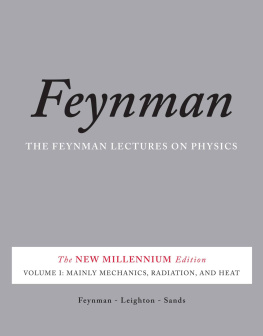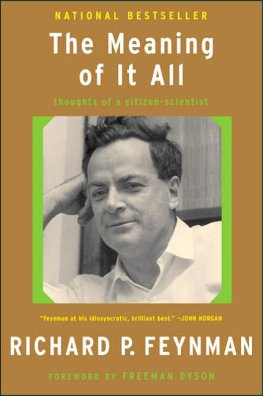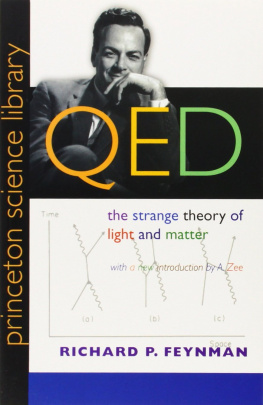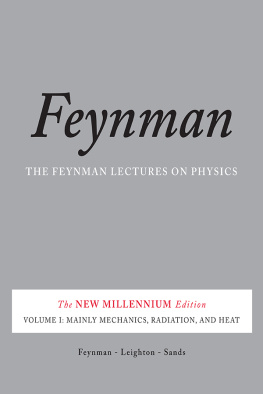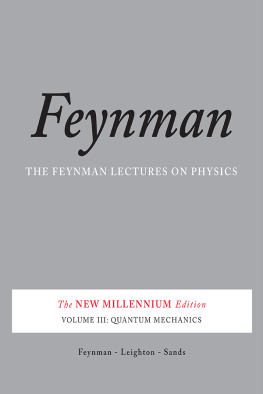Richard Feynman
Born in 1918 in New York City, Richard P. Feynman received his Ph.D from Princeton in 1942. Despite his youth, he played an important part in the Manhattan Project at Los Alamos during World War II. Subsequently, he taught at Cornell and at the California Institute of Technology. In 1965 he received the Nobel Prize in Physics, along with Sin-Itiro Tomonaga and Julian Schwinger, for his work in quantum electrodynamics.
Dr. Feynman won his Nobel Prize for successfully resolving problems with the theory of quantum electrodynamics. He also created a mathematical theory that accounts for the phenomenon of superfluidity in liquid helium. Thereafter, with Murray Gell-Mann, he did fundamental work in the area of weak interactions such as beta decay. In later years Feynman played a key role in the development of quark theory by putting forward his parton model of high energy proton collision processes.
Beyond these achievements, Dr. Feynman introduced basic new computational techniques and notations into physicsabove all, the ubiquitous Feynman diagrams that, perhaps more than any other formalism in recent scientific history, have changed the way in which basic physical processes are conceptualized and calculated.
Feynman was a remarkably effective educator. Of all his numerous awards, he was especially proud of the Oersted Medal for Teaching, which he won in 1972. The Feynman Lectures on Physics, originally published in 1963, were described by a reviewer in Scientific American as tough, but nourishing and full of flavor. After 25 years it is the guide for teachers and for the best of beginning students. In order to increase the understanding of physics among the lay public, Dr. Feynman wrote The Character of Physical Law and QED: The Strange Theory of Light and Matter. He also authored a number of advanced publications that have become classic references and textbooks for researchers and students.
Richard Feynman was a constructive public man. His work on the Challenger commission is well known, especially his famous demonstration of the susceptibility of the O-rings to cold, an elegant experiment which required nothing more than a glass of ice water and a C-clamp. Less well known were Dr. Feynman's efforts on the California State Curriculum Committee in the 1960s, where he protested the mediocrity of textbooks.
A recital of Richard Feynman's myriad scientific and educational accomplishments cannot adequately capture the essence of the man. As any reader of even his most technical publications knows, Feynman's lively and multi-sided personality shines through all his work. Besides being a physicist, he was at various times a repairer of radios, a picker of locks, an artist, a dancer, a bongo player, and even a decipherer of Mayan hieroglyphics. Perpetually curious about his world, he was an exemplary empiricist.
Richard Feynman died on February 15, 1988, in Los Angeles.
Robert Leighton
Born in Detroit in 1919, Robert B. Leighton did ground-breaking work in solid state physics, cosmic ray physics, the beginnings of modern particle physics, solar physics, planetary photography, infrared astronomy, and millimeter- and submillimeter-wave astronomy over the course of his life. He was widely known for his innovative design of scientific instruments, and was deeply admired as a teacher, having authored a highly influential text, Principles of Modern Physics, before joining the team developing The Feynman Lectures on Physics.
In the early 1950s Leighton played a key role in showing the mu-meson decays into two neutrinos and an electron, and made the first measurement of the energy spectrum of the decay electron. He was the first to observe strange particle decays after their initial discovery, and elucidated many of the properties of the new strange particles.
In the mid-1950s Leighton devised Doppler-shift and Zeeman-effect solar cameras. With the Zeeman camera, Leighton and his students mapped the sun's magnetic field with excellent resolution, leading to striking discoveries of a five-minute oscillation in local solar surface velocities and of a super-granulation pattern, thus opening a new field: solar seismology. Leighton also designed and built equipment to make clearer images of the planets, and opened another new field: adaptive optics. His were considered the best images of the planets until the era of space exploration with probes began in the 1960s.

